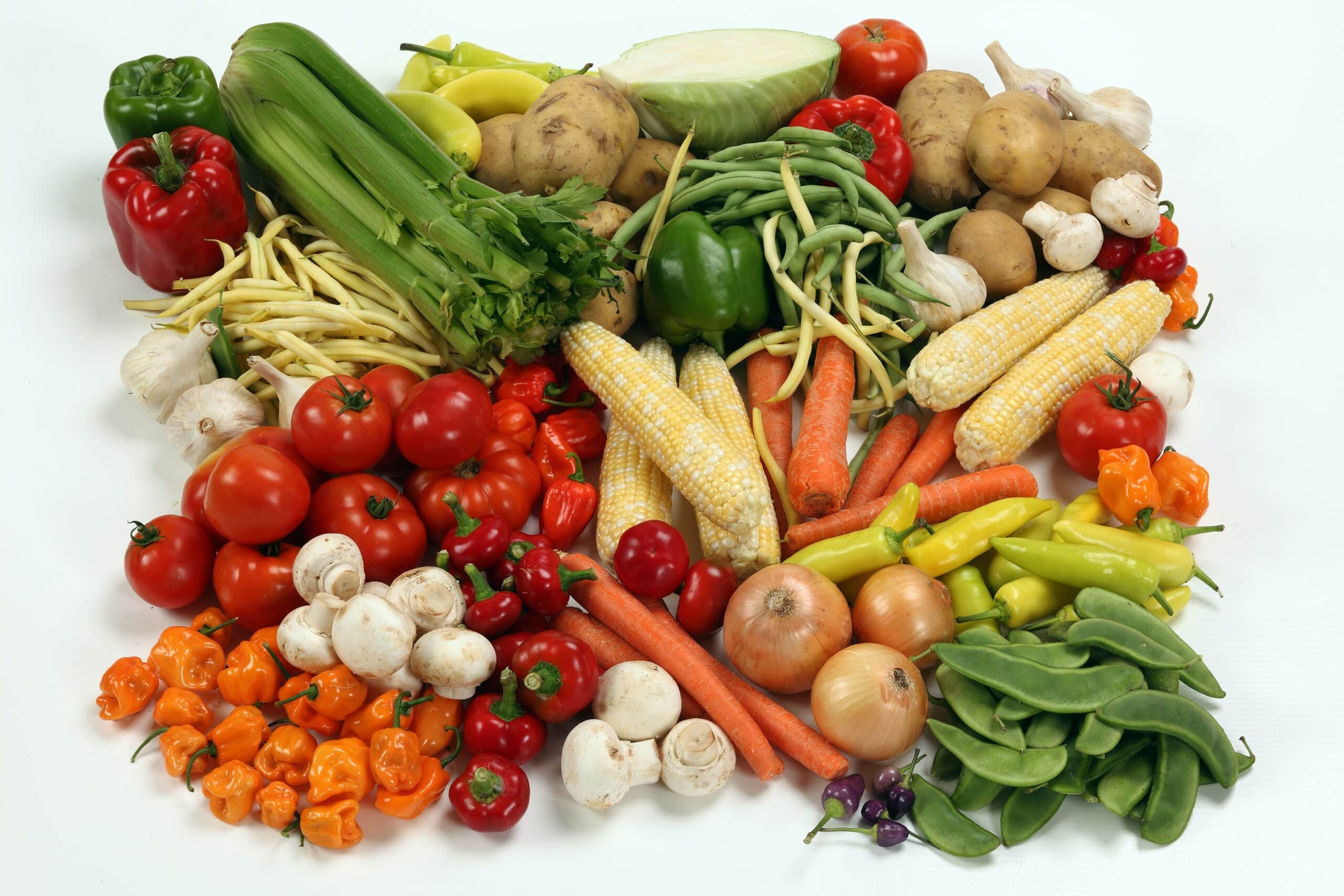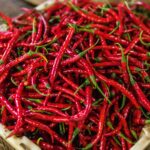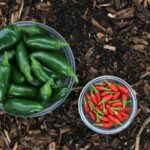Do you have a green thumb and want to start growing peppers in your garden? Peppers are the most commonly grown vegetables across the globe; in fact, according to the National Gardening Association, nearly 25% of all home vegetable gardens contain peppers. Growing peppers can be an enjoyable and rewarding experience with beautiful and delicious results. This step-by-step guide will walk you through everything you need to know about how to successfully grow peppers.
The first thing to consider when growing peppers is finding the right type of pepper for your garden. Whether you’re looking for sweet bell peppers or fiery habaneros, there are dozens of varieties that can bring flavor and beauty to your garden. Once you’ve selected your variety, it’s time to prepare the soil for planting. The ideal soil for growing peppers should be rich in organic matter and have good drainage, as well as a pH between 6 and 7; if needed, adding compost or other soil amendments can help balance out the pH levels.
Finally, once your soil is prepared its time to plant! Planting pepper seeds can be done either indoors or outdoors depending on preference and climate; however, when transplanting seedlings outdoors, make sure they are planted after all danger of frost has past. With proper care and maintenance such as providing adequate water and nutrients throughout the season, you’ll soon have a thriving pepper garden full of vibrant colors and delicious flavors!
Selecting The Best Variety For Your Climate
When deciding which pepper varieties to grow, it’s important to consider your climate. Different peppers thrive in different temperatures and humidity levels, so you’ll need to research the best options for your area. Hotter climates may be able to handle spicier peppers while cooler areas are better suited for milder ones. You should also pick a variety that will be ready to harvest when the growing season comes to an end.
Once you’ve determined the right type of pepper for your region, it’s time to move onto preparing the garden bed for planting. Start by removing any weeds and grass from the area where you intend to plant. If possible, incorporate organic matter such as compost or manure into the soil to give your plants an extra boost of nutrition. Make sure the soil is not too compacted, as peppers need plenty of air circulation around their roots in order to thrive.
You can also use mulching materials such as straw or wood chips around each plant after you have finished planting them in order to help retain moisture and discourage weed growth. This is especially important during dry periods as peppers require consistent watering throughout their growing season in order to produce large, juicy fruits. With these steps complete, you’re now ready for the final step of planting your peppers!
Preparing The Garden Bed For Planting
We all know that one of the most important steps in gardening is preparing the land. But who would have thought that it could be so deceptively difficult? Preparing the garden bed for planting peppers is a challenge that requires careful consideration and preparation.
Ironically, this step can often be more challenging than actually planting the peppers themselves! Getting the soil ready for planting involves assessing and amending the soil to ensure it has the right pH balance, drainage, and nutrient levels. Plus, you’ll need to make sure your chosen variety will thrive in your climate before committing to any particular pepper plant.
So, how does one go about ensuring their garden bed is sufficiently prepared to give their pepper plants a fighting chance at success? Start by removing weeds and rocks from your garden bed and then work on improving drainage by adding compost or mulch. You should also test the pH level of your soil – if it’s too acidic or alkaline, you may need to adjust it using lime or sulfuric acid accordingly. Finally, add fertilizer to enhance nutrient levels in your soil before finally setting up irrigation systems as needed.
There’s no question that preparing a garden bed for pepper planting is an arduous undertaking but with a little bit of effort and attention to detail, you can create an ideal environment for your peppers to thrive.
Planting Peppers In The Garden
Now that the garden bed is ready, it’s time to plant peppers. Peppers come in a variety of shapes and sizes, so it’s important to know what kind you’re planting before getting started. You’ll also want to make sure you’re using the right soil and fertilizer for your peppers.
When planting peppers, it’s best to place them about 12 inches apart, with a minimum of 18 inches between rows. Place the pepper plants in a hole that’s slightly larger than the root ball and fill it with soil. Make sure to firm up the soil around the plant after placing it in the ground. If you’re planting multiple types of peppers in one area, keep an eye on them so they don’t cross-pollinate!
Watering your pepper plants regularly will help them stay healthy and produce more fruit. It’s also important to mulch around your pepper plants to help retain moisture and prevent weed growth. With proper care and attention, you can expect to reap a bountiful harvest of delicious peppers in no time!
Now that we have covered when and how to plant peppers, let’s look at when we should fertilize them.
When To Fertilize Peppers
With the anticipation of seeing their hard work come to fruition, gardeners may be eager to start planting peppers. But before taking this step, it’s important to understand when and how to fertilize peppers for optimal growth.
Fertilizing peppers is an important part of the process, as it helps them reach their full potential. The best time to fertilize your pepper plants is when they are actively growing and producing fruits or flowers. To do this, mix a balanced fertilizer with water and apply it around the base of each plant about once every two weeks. Avoid using too much fertilizer as this can damage the roots and stunt their growth.
It’s also important to make sure you’re using a fertilizer that is specifically designed for peppers. This type of fertilizer should contain essential nutrients such as nitrogen, phosphorus, and potassium. These nutrients are essential for encouraging strong root growth and helping your pepper plants produce sweet and tasty fruits! With proper fertilization, you will be rewarded with a bountiful harvest of delicious peppers.
Now that gardeners know how and when to fertilize their pepper plants, it’s time to look out for common pests which may impact their growth.
Common Pests To Look Out For
Pests can be an unwelcome intruder in any garden. They threaten the health of our plants, and peppers are no exception. In this section, we’ll explore the common pests that may plague your peppers and how to keep them away.
Like a dark cloud hovering over an otherwise sunny day, pests can quickly ruin the hard work you’ve put into growing peppers. Aphids, flea beetles, and tomato hornworms are just a few of the common culprits that could potentially harm your pepper plants. Fortunately, there are ways to protect against these intruders.
Organic pest control methods like introducing beneficial bugs like ladybugs or praying mantis to your garden can be effective at controlling pests without chemical pesticides. Other options include setting up row covers to prevent flying insects from attacking your plants or hand-picking large pests like caterpillars off the foliage. Taking steps now can help ensure your pepper crop stays healthy and productive for many seasons to come.
Now it’s time to turn our attention towards another crucial part of successful pepper gardening: watering!
Watering Peppers
It can be a bit daunting to think about watering peppers, especially if you’re a beginner gardener. But it doesn’t have to be! With just a few easy steps, you can ensure that your pepper plants stay hydrated and healthy.
When it comes to watering peppers, the key is moderation. You don’t want your plants to be waterlogged or dried out – both of which can cause serious problems for the health of your plants. To get the balance right, water deeply and regularly but not too frequently. Ensure that the soil is moist at least two inches below the surface before watering again; this will help establish strong root systems in your pepper plants.
Providing enough hydration for your pepper plants is essential for their growth and productivity. When done properly, it can pay dividends when harvest time comes around. So make sure you’re keeping an eye on the moisture levels in your soil – it could make all the difference! Now let’s look at mulching to retain moisture and prevent weeds.
Mulching To Retain Moisture And Prevent Weeds
“An ounce of prevention is worth a pound of cure,” and this old adage holds true in gardening too. Mulching is an important part of gardening that helps retain moisture, prevent weeds and promote healthy plants. In this step-by-step guide to growing peppers, let’s take a look at how mulching can help your pepper plants thrive.
Mulching materials like untreated wood chips, straw or bark should be applied evenly and in a thick layer around the base of your pepper plants, ideally 2-3 inches deep. This will help conserve moisture, reduce evaporation and suppress weed growth. It also provides insulation for the soil during hot summer temperatures so that your peppers don’t get too stressed out by the heat.
Organic mulches are great for helping with water retention and promoting soil fertility as they break down over time. They also attract earthworms, which help aerate the soil and provide nutrients to your plants. Keep an eye out for pests though, as some can hide in organic mulches and cause damage to peppers if left unchecked.
These simple steps will go a long way towards helping you grow healthier peppers. Next up: staking and pruning peppers to keep them growing strong!
Staking And Pruning Peppers
Ah, the joy of finally reaching that last step in growing peppers – staking and pruning! As anyone who’s grown peppers before knows, this is a crucial step in ensuring that they reach their full potential. But don’t be intimidated – these final steps are easy to get through with a minimum of fuss.
The first thing you’ll need to do is stake your pepper plants. This will help keep them upright and supported as the fruits develop, preventing them from falling over or breaking off prematurely. You can use wooden stakes or even pieces of string tied around the stalk of the plant – whatever works best for you! If you have multiple plants in one area, it’s often helpful to tie them together for added stability.
Now that your plants are staked, it’s time to start pruning them. Pruning helps promote better air circulation and more productive growth overall, so it’s an important part of caring for pepper plants. Start by removing any weak or dead stems and leaves, then snip off any suckers (side shoots) that appear below the main stem. Finally, trim away any extra foliage that may be blocking light from reaching the fruits themselves!
With these steps complete, you’re ready to move on to harvesting and storing your peppers!
Harvesting And Storing Peppers
Did you know that peppers can be harvested as early as 55 days after planting? This means that in less than two months, you can reap the rewards of your gardening labour. It’s time to move on to harvesting and storing peppers!
The process of harvesting and preserving peppers is relatively easy, but there are a few key points to keep in mind. First, it’s important to pick the right pepper at the right time. When mature, peppers should be firm and brightly coloured. If left on the plant for too long, they will become overly ripe and lose flavour. Additionally, when harvesting a pepper, pick it from the stem rather than pulling or twisting it off. This will limit damage to the plant and encourage more production over time.
Once you have collected all your ripe peppers, store them in an airtight container for up to one week in the fridge or freeze them for future use. Be sure to clean any dirt or debris off before storing so that your fruits stay fresh and flavourful! With these tips in mind, you’re ready to begin enjoying all those delicious homegrown peppers!
Common Diseases To Watch For
It’s a beautiful sight when the last step of growing peppers is finally reached, and their vibrant colors are bursting through the soil. But it’s important to remember that our work isn’t done yet. Once harvesting and storing peppers has been completed, we must be aware of common diseases that can affect them.
First, it is important to note what types of diseases can occur in peppers, and how they can be prevented. Common diseases include bacterial leaf spot, anthracnose, blight, Alternaria blight, and crown rot. Each one must be managed differently in order to avoid them from spreading and infecting the plants. Properly preparing the soil for planting by removing any debris or weeds can help reduce the risk of disease. Additionally, rotating crops every year and keeping crop residue out of the garden will further prevent outbreaks from occurring.
When dealing with an outbreak, chemical treatments may be necessary depending on the severity of infection. If possible, try using natural methods such as crop rotation or mulching instead of pesticides. These methods are not only safer for your plants but also for you and your family since you don’t have to handle hazardous chemicals.
Though it may seem like an intimidating task at first glance, preventing pepper diseases is really quite simple if done correctly. With a little bit of knowledge and attention to detail throughout the growing season, we can ensure our peppers remain healthy and strong all season long! Onward then to companion planting with peppers – let us learn now how best to use our neighbors in the garden!
Companion Planting With Peppers
It’s finally time to take the plunge and plant your peppers! But before you do, don’t forget about the importance of companion planting. Yes, that’s right – it turns out peppers are just like us in many ways and need some friends too! So let’s have a look at which other plants will get along best with your pepper plants.
Companion planting is done for a variety of reasons – from deterring pests, to providing extra nutrition to the soil. And when it comes to peppers, there are several plants that can be planted alongside them for optimal results. Some of these include carrots, onions, garlic, basil, oregano and marigolds. These all help improve the flavor of your peppers as well as providing protection from other pests.
Now that you’re equipped with this knowledge on choosing the perfect companions for your pepper plants, you’re ready to start growing your own peppers! This guide has shown you exactly how to do that – from selecting the right varieties through to harvesting and storing. All that’s left now is to head off into the garden and get started!
Common Problems And Solutions
One example of a common problem when growing peppers is disease. A good way to prevent this is by regularly checking the plants for any signs of infection, like discoloration or wilting. It’s also important to use disease-resistant varieties whenever possible.
When it comes to pests, they can be a major issue when it comes to growing peppers. Keeping an eye out for bugs, like aphids and spider mites, is essential in order to keep your pepper plants healthy. Regular treatment with insecticides should be done as soon as you notice any infestations.
Finally, pay attention to soil health and drainage. Peppers need nutrient-rich soil that drains well in order for them to thrive. If the soil doesn’t drain properly, consider adding organic matter like compost or mulch to improve its structure and help with water retention. This will ensure that your pepper plants get the nutrition they need in order to produce a bountiful harvest! With these tips in mind, you’ll be well on your way towards successfully growing peppers!
Troubleshooting Tips
It’s the time of year for peppers to be thriving – and there are a few bumps in the road along the way. This section is all about troubleshooting tips, to help you get your peppers growing without any hiccups.
To start with, it’s important to keep an eye out for pests that can affect your pepper plants – aphids and whiteflies being two of the biggest culprits. As they say, a stitch in time saves nine: taking preventative measures such as planting companion crops or using insecticidal soap can go a long way towards ensuring your crop remains healthy.
Additionally, make sure the soil around your plants is well aerated to avoid root rot. Amending your soil with organic matter or compost can help with drainage and provide added nutrients to encourage growth. Pay attention to watering habits and ensure you’re not overwatering, which can cause nutrient deficiencies or even plant death.
While looking out for potential problems is key, don’t forget about providing your plants with plenty of sunlight as well as proper nutrition for optimal growth. With these troubleshooting tips you’ll be on your way to a successful harvest!
Tips For Growing Peppers In Containers
Growing peppers in containers is a great way to add flavor to your meals and add some color to your outdoor space. If you’re pressed for space, it’s an ideal solution for getting a pepper yield without having to take up precious garden or yard real estate.
There are a few things to consider when growing peppers in containers: container size, soil type, and drainage. You’ll need a container with enough depth and width to accommodate the root system of the pepper plant, as well as enough room for soil that is loose and has good drainage. Soil should be light and airy – not too dense – so the roots are able to spread out and breathe. Ensure that you punch holes into the bottom of the container before planting so excess water can drain away properly.
Finally, make sure your peppers get plenty of sun throughout the day; they need at least 6-8 hours of direct sunlight each day in order to flourish. Once you’ve taken care of these considerations, you can sit back and watch your pepper plants grow! With proper care and attention, you’ll soon be able to enjoy the delicious fruits of your labor!
Enjoying The Fruits Of Your Labor
Ah, the fruits of your labor! After following a step-by-step guide and putting in all that hard work, there’s nothing quite like reaping the rewards. Growing peppers can be an incredibly rewarding experience, and with these 15 tips you’ll soon be enjoying the bountiful harvest from your own backyard.
The first step is to select a container that is large enough for the pepper plants to grow in. Once you’ve chosen and planted your peppers, it’s important to water them regularly and keep them in an area with plenty of sunshine. You’ll also need to feed the plants with a fertilizer every few weeks.
Now comes the exciting part – harvesting! As the peppers ripen they will turn different colors depending on what kind they are. When they reach full maturity, use scissors or kitchen shears to cut them off right at their stems. Enjoying the fruits of your labor is one of life’s greatest pleasures – savor each bite as if you worked for it with your own two hands!
Frequently Asked Questions
How Often Should I Water My Peppers?
When it comes to watering peppers, consistency is key. You should aim to water your peppers once a week, or when the top inch of soil feels dry. Be sure to check the soil before you water – if it’s wet, then wait until it dries out.
When you do water, be sure to provide enough moisture so that the soil is thoroughly saturated and there are no dry spots left behind. It’s best to use a watering can with a soft spray nozzle as this will help avoid washing away your plants’ nutrients. Additionally, try to water in the morning or evening as opposed to during the heat of the day because this will reduce evaporation and ensure that more of the water reaches your plants’ roots.
Taking care of your peppers doesn’t stop with watering; you’ll also need to provide adequate sunlight and fertilizer throughout the season for healthy growth and production. Aim for at least six hours of direct sun per day and fertilize every two weeks using an organic fertilizer specifically designed for vegetables like peppers. With proper care and attention, you can grow delicious peppers all season long!
How Much Sun Do Peppers Need?
When cultivating peppers, it’s important to know how much sunlight they need. Sun is essential for pepper plants to thrive, and knowing the sun requirements for your specific type of pepper can help ensure a successful harvest.
Generally speaking, peppers need six to eight hours of direct sunlight each day. That said, some varieties require more or less depending on their origin. For example, milder peppers such as bell peppers usually need less sun than hotter varieties like jalapenos. It’s also important to note that when temperatures are very high, you may need to provide shade for your pepper plants in order to protect them from sunburn.
Additionally, the amount of sunlight needed by peppers changes throughout the season. When they first sprout, young seedlings should be grown in filtered light until they become established before being moved into full sunlight. As they mature, more sun will be needed – especially if you’re hoping for a large crop of ripe fruits! By taking the time to understand your pepper plants’ needs and providing them with adequate amounts of sun exposure, you can enjoy a plentiful harvest come harvest time.
What Temperature Should I Keep My Peppers At?
When it comes to growing peppers, temperature is an important factor. How warm your pepper plants should be will depend on the type of pepper you’re trying to grow. For most varieties, temperatures between 65 and 80 degrees Fahrenheit are ideal for optimal growth and fruit production.
It’s important to note that peppers prefer a consistent temperature. If temperatures dip too low during the night or day, it can slow down their growth and limit production of peppers. To ensure that your peppers stay within the optimal range, use a thermometer around your pepper plants and monitor the temperature daily.
With careful monitoring, you can make sure that your pepper plants get the right amount of warmth for them to thrive. With proper care, you’ll be able to enjoy a bumper crop of healthy peppers!
How Can I Tell If My Peppers Are Ripe?
Knowing when your peppers are ripe can be a tricky business. Like many fruits and vegetables, it takes a keen eye to spot the signs that peppers are ready for harvest. Fortunately, there are some key indicators that you can look out for to ensure that your peppers are at their peak flavor and nutrition.
The first sign of ripeness is color change; if the skin of your pepper has changed from green to red or yellow, then it’s likely ready to harvest. Additionally, if your pepper feels firm but not hard when gently squeezed, this is another indicator that they’re ripe and ready to be picked. You should also take note of any wrinkling or softening of the pepper’s skin- these are usually good signs of ripeness as well.
Finally, if you’re still unsure about whether or not your peppers are ready for picking, simply take a nibble- if it’s juicy and sweet with no bitterness in the taste, then that’s a surefire way to tell that you’ve got yourself a ripe pepper! Keep an eye out for these indicators throughout the growing process and you’ll have no problem harvesting delicious peppers in no time.
Is It Necessary To Prune My Pepper Plants?
Pruning your pepper plants is an important part of the process in order to ensure a healthy and fruitful harvest. Pruning helps to encourage bushier growth, which leads to more peppers, as well as increased air circulation throughout the plants. It can also help limit fungal diseases by removing any dead or damaged branches.
There are a few different ways you can prune your pepper plants. You can begin by removing any dead or damaged leaves and stems, and then trim away any overly long branches, leaving no more than four or five branches per plant, with each branch having three to four leaves. Additionally, it’s important to remove any flowers that appear before the fruit has had a chance to develop – this will help direct more energy towards producing the peppers themselves.
When pruning pepper plants, it’s important to use sharp scissors or pruners and make clean cuts at the nodes – this will help avoid infection from fungus and bacteria that can enter through ragged cuts. Taking these steps will help maximize your pepper crop!
Conclusion
Growing peppers is a rewarding experience that can bring a lot of joy and deliciousness to your garden. With the right care and attention, you can reap the benefits of this flavorful vegetable. It may take some time to get the hang of things, but with this guide, you’ll be able to grow a bountiful harvest in no time!
Watering your plants properly, making sure they get plenty of sun and keeping them at the correct temperature will help ensure that they reach their peak potential. It’s also important to keep an eye on their ripeness so that you can enjoy fully grown peppers. Pruning isn’t necessary for all pepper plants, but if yours requires it then it’s essential for the health of your plant.
Whether you’re an experienced gardener or just starting out, growing peppers is a great way to add flavor and color to your garden! With patience, dedication, and this step-by-step guide, you’ll be harvesting bushels of peppers in no time — like an absolute pro!





























